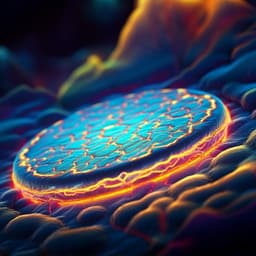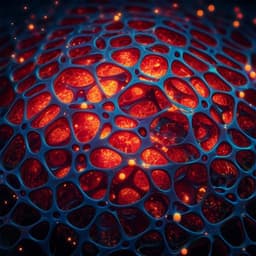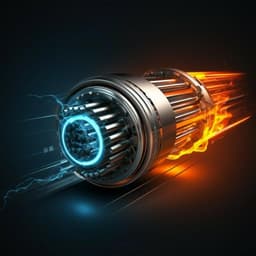
Chemistry
Thermal synthesis of conversion-type bismuth fluoride cathodes for high-energy-density Li-ion batteries
J. F. Baumgärtner, F. Krumeich, et al.
This study by Julian F. Baumgärtner, Frank Krumeich, Michael Wörle, Kostiantyn V. Kravchyk, and Maksym V. Kovalenko introduces a scalable method to synthesize highly crystalline orthorhombic BiF3. Remarkably, this research demonstrates enhanced cyclic stability of BiF3 in ionic liquid electrolytes, achieving an impressive initial capacity of 208 mA g−1 with significant retention over 80 cycles.
~3 min • Beginner • English
Introduction
The study addresses the need for higher energy density Li-ion batteries by exploring conversion-type cathodes, focusing on bismuth fluoride (BiF3). Conversion metal fluorides offer high oxidative stability, high lithiation potentials (>2 V vs. Li+/Li), and high theoretical capacities (302–712 mAh g−1), potentially enabling energy densities beyond those of intercalation cathodes. BiF3 is particularly attractive due to its 302 mAh g−1 theoretical capacity, average discharge voltage near 3.0 V, low theoretical volume change (~1.7%) upon lithiation, and low voltage hysteresis (~0.4 V), which are superior to many other metal fluorides (e.g., FeF3 with ~26% volume change and 1.5–2 V hysteresis). Key challenges include hazardous conventional syntheses (HF or NH4F routes) and poor cycling stability in carbonate electrolytes arising from Li2CO3-rich cathode–electrolyte interfaces (CEIs) formed upon reduction catalyzed by Bi0. The study aims to (i) develop a low-cost, robust, and scalable route to phase-pure BiF3 via thermal decomposition of a non-toxic single-source precursor, and (ii) evaluate ionic liquid (IL) electrolytes as an alternative to carbonate-based electrolytes to improve the cycling stability of BiF3 cathodes.
Literature Review
The paper situates BiF3 within the broader context of conversion-type metal fluorides (Fe, Cu, Bi, Ni), emphasizing their high voltages and capacities relative to intercalation cathodes, and discussing potential energy densities when paired with Li metal. Prior BiF3 work showed favorable volume change and low hysteresis but suffered from poor capacity retention in carbonate electrolytes due to Li2CO3 CEI formation. Traditional BiF3 syntheses use hazardous fluorine sources (HF, NH4F) and aqueous routes prone to oxofluoride impurities. Ionic liquids, particularly imidazolium and pyrrolidinium salts with LiFSI, have previously enabled improved cycling and stable interphases for both conversion (e.g., FeF2) and intercalation electrodes. Prior high-energy ball-milling studies suggested phase transformations (e.g., to a tysonite-type phase), indicating processing-sensitive polymorphism and microstructure effects on electrochemistry.
Methodology
Synthesis: Bi(TFA)3 precursor was synthesized from Bi2O3 using trifluoroacetic acid (TFAH) and trifluoroacetic anhydride (TFAA) at 60 °C for 24 h under N2, followed by solvent removal to obtain a white powder (96% yield). BiF3 was produced by thermal decomposition of Bi(TFA)3 in an N2 atmosphere: loading into an alumina crucible within a sealed quartz tube, heating with controlled ramps to 300 °C (held for 12 h), then cooling, yielding air-stable, highly crystalline orthorhombic BiF3 (Pnma) in quantitative yield (100%). Stability under air was assessed over 3 months.
Characterization: Powder XRD (Cu Kα) with Rietveld refinement (GSAS-II) confirmed orthorhombic BiF3 (Pnma, a = 6.5604 Å, b = 7.0174 Å, c = 4.8450 Å), with R(F) ≈ 7% and preferred orientation along [010], consistent with flake morphology. SEM provided particle size distributions (mean diameter decreased from 4.9 µm to 1.2 µm after milling), and EDX showed low oxygen content. TEM revealed ~20 nm BiF3 nanoparticles embedded in a CNT/CB matrix after milling.
Ball-milling and composite preparation: To improve electrical contact and reduce size, orthorhombic BiF3 was dry ball-milled with carbon black (CB) and multi-walled carbon nanotubes (CNTs) at 800 rpm for 1.5 h under Ar, inducing transformation to a cubic phase (Fm-3m) and substantial reflection broadening (reduced crystallite size/strain). EDX indicated minimal oxygen impurities, suggesting α-BiF3 rather than BiOxF3−2x formation. Crack formation in particles aided carbon intermixing and coating.
Electrode fabrication: BiF3 (50 wt%), CB (20 wt%), CNTs (20 wt%) were ball-mixed under Ar; PVdF binder (10 wt%) and NMP solvent were added and milled (500 rpm, 1.5 h) to form a slurry, which was brushed onto carbon-coated Al foil disks and dried (75–80 °C). Areal BiF3 loading was ~0.1 mg cm−2.
Electrochemical testing: CR-type coin half-cells with Li metal counter/reference, glass fiber separators, and various electrolytes: carbonate-based (1 M LiPF6 in EC/DMC; 4.3 M LiPF6 in EC/DMC + 3 wt% FEC) and ionic liquid-based (1 M and 4.3 M LiFSI in Pyr1,4TFSI). For viscous/highly concentrated electrolytes, assembled cells were heated at 75 °C (IL: 24 h; 4.3 M LiPF6: 20 min) to ensure wetting. Galvanostatic cycling at 30 mA g−1 between 2–4 V vs Li+/Li was conducted; voltage profiles and differential capacity (dQ/dV) were analyzed over multiple cycles.
Key Findings
- Synthesis and structure: Thermal decomposition of Bi(TFA)3 at 300 °C under N2 yields phase-pure, highly crystalline orthorhombic BiF3 (Pnma; a ≈ 6.560 Å, b ≈ 7.017 Å, c ≈ 4.845 Å). Product is largely air-stable with minimal hydrolysis over months; synthesis in air produces BiOxF3−2x impurities.
- Microstructure tuning: Ball-milling with CNT/CB reduces mean particle size from 4.9 µm to 1.2 µm, introduces cracks, and coats particles with carbon; TEM reveals ~20 nm BiF3 nanoparticles embedded in carbon. Milling converts orthorhombic BiF3 to a cubic phase (Fm-3m) with low oxygen content by EDX.
- Electrochemistry in carbonate electrolyte (1 M LiPF6-EC/DMC): First discharge capacity ~280 mAh g−1 (near theoretical 302 mAh g−1) with reduction peaks at ~2.5 V and 2.2 V (BiF3 and BiOxF3−2x). Evidence of carbonate reduction and Li2CO3 CEI formation near ~2 V catalyzed by Bi0; on charge, oxidation peaks at ~2.5 V (Bi/Bi2O3), ~2.8 V (Bi/BiOxF3−2x), and ~3.2 V (Bi/BiF3). Over cycles, peaks shift/merge and capacity drops to ~152 mAh g−1 by cycle 10; capacity falls below 100 mAh g−1 after 38 cycles (36% retention).
- Electrochemistry in IL electrolyte (LiFSI-Pyr1,4TFSI): With 1 M concentration, only one main reduction peak ~2.4 V and one oxidation peak ~3.2 V are observed; absence of the Bi/Bi2O3 oxidation feature suggests suppressed Li2CO3 CEI and oxide formation. Highly concentrated IL (4.3 M) provides initial discharge capacity ~208 mAh g−1 with small reduction peaks at ~2.6 and 2.4 V and limited side reactions (dQ/dV does not drop below −300 mAh g−1 V−1). Oxidation occurs around 3.3–3.4 V with slight hysteresis increase (0.8→0.9 V over cycling). dQ/dV shows minimal CEI formation compared to carbonate.
- High-concentration carbonate (4.3 M LiPF6 in EC/DMC + FEC) exhibits an anomalously high initial discharge capacity (~481 mAh g−1) followed by early short circuit (114 mAh g−1 on charge), likely due to Li dendrite formation.
- Cycling stability: In 1 M LiPF6-EC/DMC, capacity retention is poor (36% after 38 cycles). In 4.3 M LiFSI-Pyr1,4TFSI, capacity retention is ~46–50% over 80 cycles at 30 mA g−1, starting from ~208 mAh g−1. Supplementary data indicate 1 M LiFSI-Pyr1,4TFSI supports 80–90 mAh g−1 over 180 cycles.
- Interpretation: IL electrolytes (oxygen-free) mitigate carbonate reduction and Li2CO3 CEI formation, hindering Bi2O3 generation and stabilizing the conversion reaction, thereby improving cycling stability.
Discussion
The work demonstrates that a safe, scalable thermal route can produce phase-pure, crystalline BiF3 suitable for cathode applications after carbon-assisted milling and downsizing. Electrochemical analyses reveal that carbonate electrolytes enable near-theoretical first-cycle capacity but suffer from parasitic carbonate reduction, Li2CO3 CEI accumulation, Bi0-catalyzed side reactions, and evolving reaction pathways (Bi2O3 and BiOxF3−2x formation). In contrast, ionic liquid electrolytes (LiFSI in Pyr1,4TFSI), particularly at high salt concentration, suppress oxygen-containing CEI formation and the associated Bi/Bi2O3 process, yielding simpler and more reversible Bi/BiF3 conversion with fewer side reactions. This directly addresses the central hypothesis that IL electrolytes can improve the cycling stability of conversion-type BiF3 cathodes. The improved retention (≈46–50% after 80 cycles) and stable dQ/dV signatures support the formation of a more stable CEI in ILs that reduces continuous electrolyte decomposition. Microstructural optimization via milling (reduced particle size, carbon coating, crack-assisted percolation) likely enhances electron/ion transport and mechanical integrity during conversion, complementing the electrolyte effect. The observed peak shifts with cycling in carbonate media point to contact loss and phase homogenization (toward BiOxF3−2x), underscoring the importance of interfacial and structural control for conversion cathodes.
Conclusion
A facile, low-cost, scalable synthesis of crystalline BiF3 via thermal decomposition of a single-source Bi(TFA)3 precursor under N2 was established, producing phase-pure orthorhombic BiF3 that can be processed into conductive composites through ball-milling with carbon. Systematic electrochemical evaluation shows that ionic liquid electrolytes (LiFSI in Pyr1,4TFSI) significantly enhance the cycling stability of BiF3 compared to conventional carbonate electrolytes by suppressing Li2CO3-rich CEI formation and associated side reactions. In highly concentrated IL electrolyte (4.3 M LiFSI-Pyr1,4TFSI), BiF3 delivers an initial capacity of ~208 mAh g−1 with ~50% retained after 80 cycles at 30 mA g−1. Future work could focus on further reducing particle size and optimizing carbon architectures to enhance kinetics, fine-tuning IL compositions/concentrations to balance conductivity and interfacial stability, increasing active mass loading while maintaining performance, and clarifying polymorph/oxofluoride contributions during cycling via advanced operando characterization.
Limitations
- Structural ambiguity after milling: Powder XRD cannot unambiguously distinguish cubic α-BiF3 from BiOxF3−2x due to similar patterns; EDX suggests low O content but minor oxygen impurities remain possible.
- Quantification limits: Significant peak broadening and polydispersity precluded meaningful strain/crystallite size quantification by XRD.
- Electrochemical artifacts in concentrated carbonate: 4.3 M LiPF6 in EC/DMC exhibited excessive first-cycle capacity and short-circuiting, likely due to Li dendrites, limiting assessment in this electrolyte.
- Low cathode loading (~0.1 mg cm−2): Results may not directly translate to higher, practical areal loadings.
- Capacity retention, while improved in ILs, still declines to ~46–50% after 80 cycles; voltage hysteresis increases slightly.
- Heat treatment needed for IL wetting; cell preparation sensitivity noted (e.g., gas evolution in concentrated carbonate upon prolonged heating).
Related Publications
Explore these studies to deepen your understanding of the subject.







